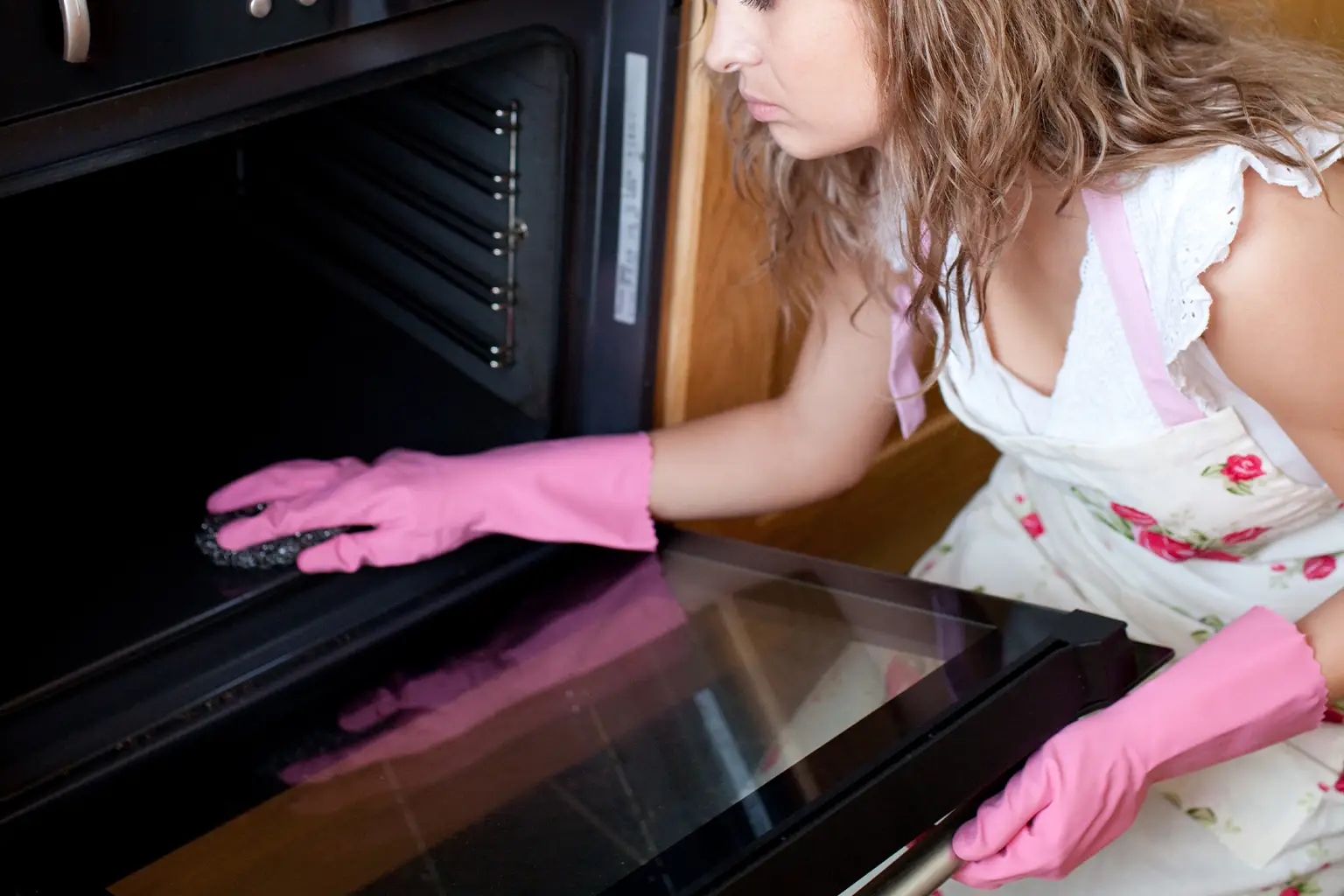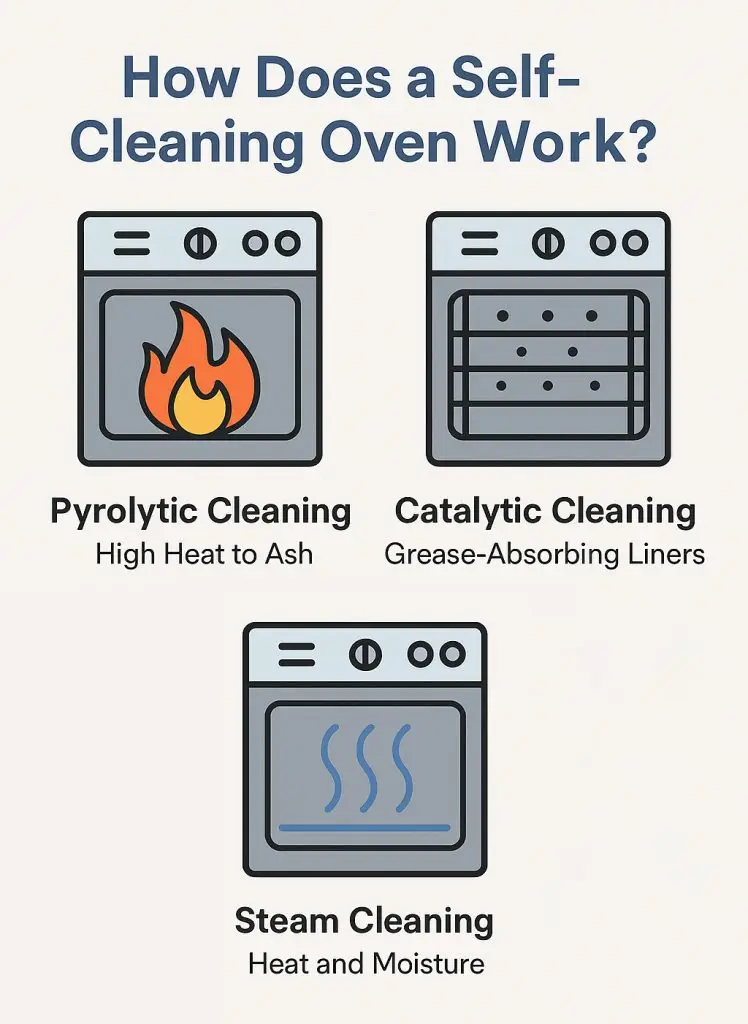
Self‑Cleaning Ovens: Types, How They Work & Safety Guide
A self-cleaning oven is a modern kitchen appliance designed to make one of the least enjoyable household chores much easier – oven cleaning. Instead of hours spent scrubbing away burnt-on grease and food spills, these ovens feature built-in cleaning systems that reduce mess to ash or loosen dirt for easy wiping.
People choose self-cleaning ovens for several reasons:
- Convenience – no harsh scrubbing or heavy chemicals needed.
- Time-saving – cycles clean the oven while you get on with other tasks.
- Hygiene – high-temperature or steam cleaning helps remove lingering grease, bacteria, and odours.
In this guide, we’ll explore everything you need to know about self-cleaning ovens. From the different types of cleaning systems – pyrolytic, catalytic, and steam – to how each one works, we’ll also cover the benefits and drawbacks, energy use, safety considerations (including oven fumes), and essential maintenance tips. By the end, you’ll know exactly whether a self-cleaning oven is right for your home.
Types of Self-Cleaning Ovens
Not all self-cleaning ovens work in the same way. There are three main types, each using a different cleaning method with its own advantages and drawbacks. Understanding these will help you decide which is best for your cooking style and household needs.
Pyrolytic Cleaning Ovens
Pyrolytic ovens use extremely high heat, often reaching up to 500°C, to incinerate grease, food residues, and spills inside the cavity. The intense cycle reduces dirt to a fine ash, which can then be wiped away with a damp cloth once the oven cools down.
- Thorough, deep cleaning with minimal effort
- Does not require chemicals
- Cycle times are usually long (2 – 4 hours) and use more energy
Catalytic Cleaning Ovens
Catalytic ovens feature special liners on the interior walls that absorb grease and break it down during normal cooking temperatures (around 200°C or above). They reduce build-up over time, though they may need replacing every few years for continued effectiveness.
- Low-maintenance and work during regular cooking
- Less energy-intensive than pyrolytic cleaning
- Not as thorough – heavy spills may still need manual cleaning
Steam / Self-Steam Clean Ovens
Steam cleaning ovens use water and steam to soften grease and food residue inside the cavity. You simply add water to the base of the oven or a reservoir, run the steam cycle, then wipe down the softened dirt.
- Quick, usually under 30 minutes
- Eco-friendly with lower energy use
- Best for light cleaning rather than burnt-on mess
Comparison Table
| Type | Cleaning Method | Cost | Pros | Cons |
|---|---|---|---|---|
| Pyrolytic | High heat burns residue to ash | Higher purchase price | Deep clean, chemical-free | Long cycle, high energy use, produces fumes |
| Catalytic | Grease-absorbing liners | Mid-range | Works during normal cooking, low effort | Less thorough, liners need replacing |
| Steam | Water and steam loosen dirt | Generally lower cost | Fast, eco-friendly, gentle | Not effective on stubborn residue |
How Does a Self-Cleaning Oven Work?
Each type of self-cleaning oven works differently, but the goal is the same: to make oven cleaning easier and reduce the need for harsh chemicals. Here’s a breakdown of how the three main systems operate.
Pyrolytic Cleaning – High Heat to Ash
Pyrolytic ovens rely on extreme heat to burn away dirt and grease. The oven door automatically locks for safety, and the temperature rises to around 400 – 500°C. At these levels, all food residues, grease splatters, and spills are incinerated into a fine ash.
Once the cycle ends and the oven has cooled, you simply wipe the cavity with a damp cloth to remove the ash. This method provides the most thorough clean but takes the longest (typically 2 – 4 hours) and consumes the most energy.
Catalytic Cleaning – Grease-Absorbing Liners
Catalytic ovens use special liners on the sides of the oven cavity. These are coated with a rough, porous material that absorbs grease splashes and gradually breaks them down during regular cooking at temperatures above 200°C.
Because the cleaning happens passively while you cook, there’s no long cycle to run. However, the liners have a lifespan and may need replacing every few years to remain effective. Heavier spills on the oven base or door still require manual cleaning.
Steam Cleaning – Heat and Moisture
Steam ovens (or ovens with a steam-cleaning function) use water and heat to loosen food residues. You add water to the base of the oven or a dedicated reservoir, then start a short cleaning cycle. The oven heats the water to create steam, which softens grease and grime.
After the cycle (usually 15–30 minutes), you wipe away the loosened dirt with a cloth. This is a fast and eco-friendly method, though it’s most effective for light, fresh spills rather than heavy, burnt-on residue.

Pros and Cons of Self-Cleaning Ovens
Pros
- Convenience – no scrubbing or harsh oven cleaners needed.
- Less effort – the oven does most of the work for you.
- Hygienic – high temperatures or steam remove grease, bacteria, and odours.
- Modern technology – often found in premium ovens with advanced features.
Cons
- Higher upfront cost – self-cleaning models are more expensive than standard ovens.
- Fumes and odours – pyrolytic cycles in particular can produce smoke or smells.
- Long cleaning cycles – pyrolytic cleaning takes 2 – 4 hours to complete.
- Electricity usage – running a high-heat cycle consumes significant energy.
Summary Table
| Pros | Cons |
|---|---|
| Convenience – no scrubbing required | Higher upfront cost |
| Hygienic – removes grease, bacteria, odours | Fumes or odours during cleaning |
| Less effort – oven does the work | Long cycle times (2–4 hours for pyrolytic) |
| Modern features often included | Higher electricity usage |
Are Self-Cleaning Oven Fumes Toxic?
One of the most common concerns about self-cleaning ovens, especially pyrolytic models, is the release of smoke and odours during a cleaning cycle. Understanding the risks and taking precautions ensures safe use for your household.
What Happens During a Pyrolytic Cycle?
When a pyrolytic oven heats up to around 500°C, food residue, grease, and spills are incinerated. This process can release:
- Smoke from burnt food deposits
- Odours that may smell unpleasant
- Fumes from the breakdown of residues on oven walls and racks
While modern ovens are designed with safety in mind, these emissions can still be irritating in enclosed or poorly ventilated spaces.
Safety for Humans and Pets
For most adults, occasional exposure to the fumes is not harmful, though it may cause mild irritation for those with asthma or sensitive lungs. However, pets are more vulnerable, particularly birds, which have delicate respiratory systems. Even small amounts of fumes can be dangerous for them.
For this reason, it’s best to remove birds, cats, and dogs from the kitchen area (or ideally the home) during a pyrolytic cleaning cycle.
Tips for Ventilation and Safe Use
- Always open windows or run an extractor fan during cleaning cycles.
- If possible, vacate the kitchen while the cycle runs.
- Keep pets in a separate, well-ventilated room until the oven cools completely.
- Wipe away large food spills before starting a cycle to minimise smoke and fumes.
With proper ventilation and care, self-cleaning ovens are safe to use. The key is preparation: clear away excess residue and keep pets and sensitive family members away until the process is complete.
Energy Use & Efficiency
One of the main considerations when choosing a self-cleaning oven is how much energy it consumes. While these ovens save you time and effort, some cleaning modes, especially pyrolytic cycles, can use a significant amount of electricity.
How Much Energy Does a Cleaning Cycle Use?
A typical pyrolytic cleaning cycle runs for 2 – 4 hours and uses around 2 – 4 kWh of electricity. Depending on your local tariff, this could cost between 60p and £1.20 per cycle. While this is not excessive if used occasionally, it does add up over time.
By contrast, steam cleaning cycles are much shorter (15 – 30 minutes) and only consume a fraction of the energy, often under 1 kWh. Catalytic liners don’t require additional energy at all since they work during normal cooking temperatures.
Cost vs Professional Oven Cleaning Services
Hiring a professional oven cleaning service in the UK typically costs between £50 and £80 for a single oven. By comparison, running a pyrolytic self-cleaning cycle costs only a pound or so in electricity. Even with higher energy use, self-cleaning ovens are a cost-effective solution in the long run, especially for frequent cooks.
Which Type Is Most Eco-Friendly?
- Steam cleaning ovens – the most eco-friendly option, using minimal energy and no chemicals.
- Catalytic ovens – low energy impact since cleaning happens during normal cooking, but liners eventually need replacing.
- Pyrolytic ovens – most energy-intensive but deliver the deepest clean, reducing the need for chemical cleaners.
If you value eco-friendliness and low running costs, steam or catalytic ovens are the better choice. For those who want the most thorough clean, a pyrolytic oven balances higher energy use with complete convenience.

Maintenance Tips for Self-Cleaning Ovens
Although self-cleaning ovens are designed to reduce the effort of keeping your appliance spotless, they still benefit from regular care. Following a few simple maintenance steps will help extend the life of your oven and keep it performing at its best.
Best Practices
- Wipe spills quickly – clean up food or liquid spills as soon as the oven cools to prevent smoke or strong odours during the next cycle.
- Remove racks before pyrolytic cycles – oven racks and trays can discolour in high heat. Clean these separately with warm soapy water.
- Check catalytic liners – inspect liners regularly. If they lose effectiveness or become saturated, consider replacing them to maintain performance.
- Use the right cycle for the mess – for light grease, a steam clean cycle may be enough. Reserve pyrolytic cleaning for heavy build-up.
- Clean the glass door – wipe down the inner glass panel after cycles to prevent stains or streaks from becoming permanent.
- Avoid harsh chemicals – do not use abrasive cleaners, bleach, or metal scouring pads, as they can damage liners and seals.
- Inspect door seals – ensure the oven door seal is intact for safe and efficient operation. Replace if worn out or damaged.
Why Maintenance Matters
Regular maintenance helps reduce smoke, ensures efficient cleaning cycles, and prolongs the life of your oven. With the right care, a self-cleaning oven will continue to deliver convenience and hygiene for many years.
Buying Advice: Choosing the Right Self-Cleaning Oven
When shopping for a self-cleaning oven, it’s important to choose a model that matches your cooking habits, household needs, and budget. Here are the key factors to consider before making your decision.
1. Cleaning System
- Pyrolytic – best for households that cook often and want the deepest clean with minimal effort.
- Catalytic – ideal for everyday use with light to moderate cooking, offering low-maintenance cleaning.
- Steam – perfect for smaller households or those who prefer quick, eco-friendly cleaning options.
2. Budget
- Pyrolytic ovens – usually the most expensive due to advanced technology.
- Catalytic ovens – mid-range pricing with good value for regular family cooking.
- Steam-clean ovens – generally the most affordable and energy-efficient option.
3. Household Size
- Families – benefit from pyrolytic ovens that can handle heavy use and stubborn grease build-up.
- Couples or singles – may prefer catalytic or steam ovens, which are easier to maintain and use less energy.
4. Additional Features
- Timer functions – schedule cleaning cycles when it’s most convenient.
- Safety locks – especially important for pyrolytic ovens during high-heat cycles.
- Multiple cooking modes – fan-assisted, grill, or combination cooking for versatility.
- Capacity – choose a size that matches your cooking needs, from compact single ovens to larger double units.
Final Buying Tip
If you want a low-effort, premium cleaning solution, a pyrolytic oven is worth the investment. For everyday practicality with lower running costs, a catalytic or steam oven may be the smarter choice.
Frequently Asked Questions
Conclusion: Are Self‑Cleaning Ovens Worth It?
- Pyrolytic ovens – deliver the deepest clean by turning residue to ash at high temperatures; best for heavy use, with higher energy use and longer cycles.
- Catalytic ovens – great for everyday cooking; liners absorb grease during normal cooking heat, but may need replacing over time.
- Steam/self‑steam clean ovens – quick and eco‑friendly for light mess; ideal for frequent top‑ups rather than burnt‑on spills.
Used correctly, fumes from pyrolytic cleaning are manageable with good ventilation, but remember to keep pets—especially birds—well away during a cycle. Factor in running costs vs occasional professional cleaning, and follow simple maintenance tips (wipe fresh spills, remove racks before high‑heat cycles, protect seals) to keep performance high.
Bottom line: if you want a low‑effort, hygienic oven and don’t mind longer cycles now and then, a pyrolytic model is worth it. For lower energy and simpler upkeep, catalytic or steam options are excellent. Whichever you choose, this guide has covered types of self‑cleaning ovens, how they work, fume safety, energy use, and maintenance so you can buy with confidence.
- All Posts
- Cooker Hood Guides & Advice
- Dishwasher Guides & Advice
- Hob Guides & Advice
- Laundry Guides & Advice
- Microwave Guides & Advice
- Oven Guides & Advice
- Wine Cooler Guides & Advice

Discover how vented induction hobs work, combining sleek cooking with built-in extraction. Learn the benefits, features and if one’s right...

Compare gas, ceramic, solid-plate and induction hobs in one easy guide. Discover pros, cons, costs and energy efficiency. Make the...

Cut your electricity bills with smart washing habits. Discover 10 easy ways to reduce energy use with your washing machine....

Discover the different types of microwaves, from solo to combi models. Learn which one suits your kitchen best. Read our...

Find out which hob type is the cheapest to run. Compare gas, induction and electric to save on your energy...

Wondering if hob sizes are standard? Learn what to expect and how to choose the right size for your kitchen....